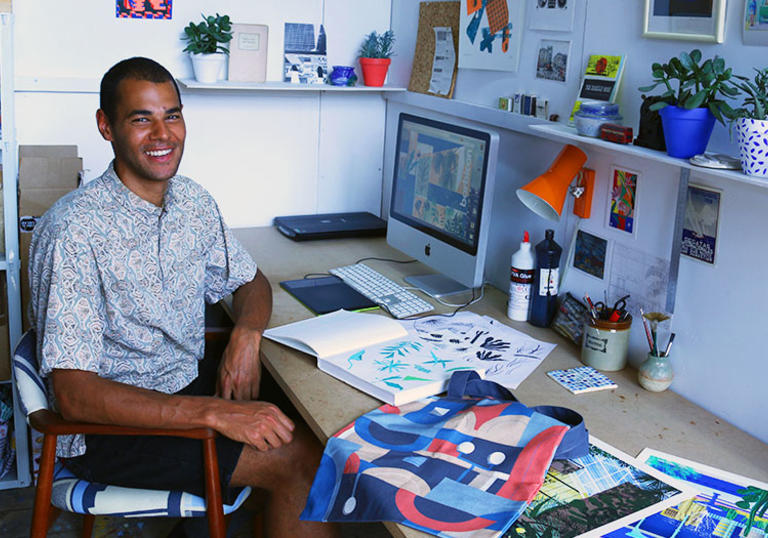How did you begin your career as an illustrator?
‘I studied illustration at Camberwell College of Art and graduated from a BA 2012. After graduating I received a few commissions which made me realise you can actually make a career out of drawing pictures. So I began working on a few freelance jobs whilst juggling a job as a graphic designer, and after a year or so I took the leap into full time freelance and it’s been working out since. ‘
What does a typical day (if there is one…!) look like in your studio?
‘Each day can vary depending on the work, but usually I’ll begin by getting the boring stuff out of the way… admin/ emails etc. After that I begin sketching ideas for a new design or illustration which can take various routes. I’ll then try out colourways – I tend to try this out digitally and then mix it up with some gouache tests. If it’s for a client there will usually be a period in which I’m waiting for feedback, so in this time I’ll work on personal projects as I usually have a painting on the go. Once the roughs have been approved I then get to work on the finished piece.’
How do you bring an idea or moment of inspiration into a design? Can you describe your creative process?
‘I find most of my inspiration from being outside exploring and whilst visiting new places. As I take most of my inspiration from buildings and the spaces they inhabit, I tend to be wandering around a lot of the time staring into space, taking photos or drawing in my sketchbook. I’ll then take all of this back to the studio and begin working up more detailed/ accurate sketches to work from.’
Has digital technology changed the way you work and create your prints? Do you still use traditional hand rendered methods?
‘Digital definitely has had a big influence on the way I produce my work. As I work with straight lines and circular forms it’s quite handy to use programs like Adobe Illustrator to help me plan my work and test out patterns before I begin working on the finished piece. This allows me to try out more options and go back and forth. I would say that my work has a balance between digital and traditional, as I paint quite a lot and I also use programs like Photoshop to create my work in a similar method. However every element will be hand drawn and scanned in, so it still has a handmade aesthetic. Having the option to make changes to a design can be really helpful both for me and for clients as it allows me to adjust the work afterwards to make it perfect for its platform. I do like to return to traditional methods though, such as screen printing or collage for example. It helps me to breakaway from the computer and avoid the square eyes.’
Your work often focuses on architecture and cityscapes – what is it that draws you to these environments in your work?
‘I’ve had a fascination with architecture for a long time now, it comes from my childhood passion for skateboarding which I’ve been doing since I was 12. I’ve always been searching for new spaces and objects to skate and it became an obsession which lead to a further appreciation for architecture. I think this has naturally found its way into my illustration as I’m now always searching for new shapes and patterns to draw.’
For your Barbican commission, which elements of the building were you particularly drawn to?
‘Well I wanted to include the semicircle shape as it’s quite a unique feature which can be found all over the estate and this combined with the rectangular balconies and facades sat together quite nicely. I tried some variations using the window patterns and passage ways to focus more on the forms that people interact with, however for this design I decided to only bring in the more individual objects, like the lights and vents to keep it simple.’
Do you have any advice for artists/designers looking to work in illustration?
‘Keep drawing the things that inspire you and get your work out there.’

